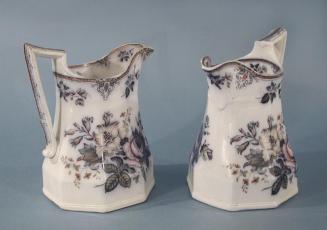Pitcher
MakerMade by
Unknown
Date1818-1825
MediumWheel-thrown cream-colored earthenware with underglaze black decoration and overglaze enamels in green, yellow, red, and blue
DimensionsPrimary Dimensions (height x width x depth): 9 x 8 7/8 x 4 7/8in. (22.9 x 22.5 x 12.4cm)
ClassificationsCeramics
Credit LineGift of Dwight Buell
Object number1888.3.0
DescriptionBarrel-shaped pitcher of cream-colored earthenware, a type of ceramic known as creamware. This is known as a "Liverpool pitcher" because many creamware pitchers of this shape with black printed designs were known to have been made and exported to America from Liverpool, England. The pitcher has a flat base, swelled sides, and a narrower rim, with a spout opposite a pulled and applied handle. The spout and handle have been decorated with bands of black enamel; there are some black enamel abstract designs on the base of the spout as well. There are two designs and one set of initials printed on the outside of the pitcher. The first oval design, located to the right of the handle, shows a small town that sits on a piece of land that juts into the water, creating a natural harbor. There are five sailing ships in the water near the shore, and seven further out to sea. There is a lighthouse visible beyond these seven ships, close to the horizon. A banner above the scene reads "The Gallant Defence of STONINGTON, August 9, 1814." A banner below the scene states "Stonington is free whilst her Heroes have one gun left." The second design, printed on the side of the pitcher to the left of the handle, is colored with yellow, blue, and red enamels. This design shows a sailing ship with three masts and two red and blue flags, floating on the sea. The title below the ship reads "United States Frigate Guerriere, Conn./ Macdonough, bound to Russia July 1818". Finally, the initials "ISH" are printed in script inside an oval wreath below the spout.
There are many light scratches on the outside of the pitcher. The pitcher has had prior conservation work along the rim to the right of the handle. A portion of the rim was rebuilt using a tan putty-like substance. No effort was made to repaint the black portions of the rim. A spot of this tan substance has adhered to the pitcher to the right of the spout.
NotesHistorical Note: In August 1814, during the War of 1812, four British vessels blockaded Stonington, Connecticut. Upon their arrival, the British gave one hour's warning for removal of noncombatants before bombarding the town. The bombardment continued from 9 August to 12 August 1814. With the help of local militia, the citizens of Stonington offered effective resistance, and the British forces were unable to land. (Hunt and Hudson 10/25/2004)There are many light scratches on the outside of the pitcher. The pitcher has had prior conservation work along the rim to the right of the handle. A portion of the rim was rebuilt using a tan putty-like substance. No effort was made to repaint the black portions of the rim. A spot of this tan substance has adhered to the pitcher to the right of the spout.
Date and Origin Note: Pitchers like this one were known to have been commissioned by Silas Burrows in France, and given to friends as a souvenir of the battle, some of the with initials of the recipient. Burrows was a teenager during the battle. If this is one of those pitchers, it is more likely that it dates to around 1830, rather than the earlier 1818-1825 date. The initials on the pitcher have not yet been matched up to anyone who may have been friend of Burrows in the battle. (Lee 3/24/2014)
Status
Not on view















